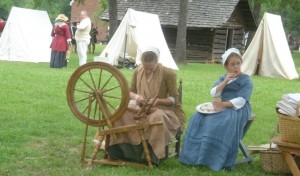The main characters in my Mysteries of the American Revolution trilogy are bourgeoise women. These women of middle and lower class also figure prominently in my Michael Stoddard American Revolution thrillers series. Fiction writers don’t often choose this point of view. Let’s face it. Being middle class isn’t glamorous during war. There are no banquets, balls, glittering gowns, or elaborate wigs. So why do I give readers a look at the lives of women who weren’t in the upper tier of society?
Different lives
Here’s the kicker. Almost never do we hear the voices of women in regard to this war. Mostly we hear the voices of men: soldiers, merchants, lawyers, etc. And if we do hear from women, it’s upper-class women such as Abigail Adams and Martha Washington.
But the gentry led lives that were different in many ways from the lives of their bourgeoise sisters. One place we really see that distinction was in army camps. During the time that an army wasn’t on the move, the female relatives of senior officers came to camp and organized dances and soirees. If these women opted to travel with the army, many could afford to spend the night sheltered in local homes, especially if they were pregnant.
The women we don’t hear about
 In contrast, when bourgeois men joined an army, their women shouldered the burden of maintaining the family farm or business. To keep from starving, they might work in excess of twelve hours a day—which helps explain why we have comparatively few letters and journals from them. If these women followed their menfolk into the army—whether the men were soldiers or civilian contractors—the women risked privation. When food was scarce, they might be forced to serve in the hospital, or cook, or launder or mend soldiers’ clothing for miniscule wages. They birthed their babies in tents. They slept in the cold with their men.
In contrast, when bourgeois men joined an army, their women shouldered the burden of maintaining the family farm or business. To keep from starving, they might work in excess of twelve hours a day—which helps explain why we have comparatively few letters and journals from them. If these women followed their menfolk into the army—whether the men were soldiers or civilian contractors—the women risked privation. When food was scarce, they might be forced to serve in the hospital, or cook, or launder or mend soldiers’ clothing for miniscule wages. They birthed their babies in tents. They slept in the cold with their men.
For Americans, the Revolution is shrouded in myths. Many of those myths paint a picture that downplays the horrors of war. But give voice to women from middle- and lower-class Revolutionary America, and you’ll hear them talk about the war in a way that’s very different from the stories told by men or upper-class women. What they say dispels myths and burrows down to the truths of humanity and the lessons of history.
Sure, the exciting lives of the Rockefellers and Kardashians of American history make for fun reading. But considering that most Americans today aren’t from the upper tier of society, it’s the stories of middle-class women during the Revolution that address us directly.
**********
Did you like what you read? Learn about downloads, discounts, and special offers from Relevant History authors and Suzanne Adair. Subscribe to Suzanne’s free newsletter.
